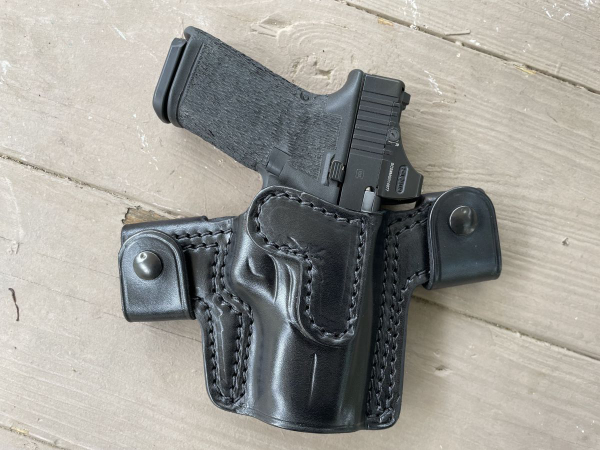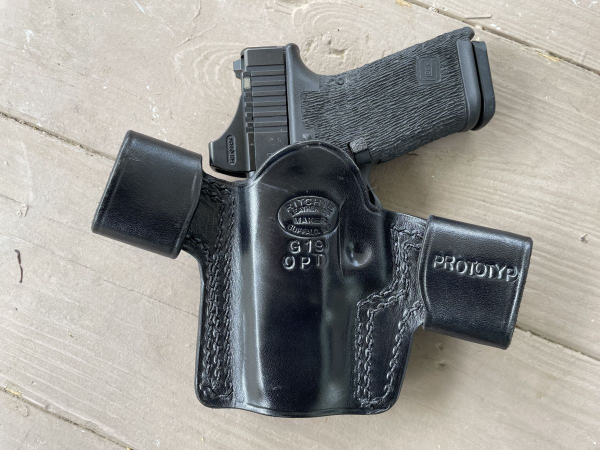Today’s feature is from correspondent Dave Spaulding.
Forward of the hip carry, what is commonly called Appendix Carry, is growing in popularity. I have no problem with this and never banned it from my courses. Hell, I carried that way once upon a time. I remember very clearly buying my first snubby off-duty revolver in 1976 (A Security Industries PPM .357 magnum J frame-sized revolver. Great gun, but a story for another time) along with a suede Bianchi clip on holster designed to be worn inside the waistband. It had to be as the holster did not have enough stiffness to support the gun outside the waistband. While I originally thought I would carry this on my hip, the effort required to “weedle” this package into place was more than I was willing to do. Solution: shove it down the front of my pants just to the side of my abdomen and cover it with a t-shirt. Problem solved.
I practiced and qualified from this holster and position and found no real problem with it. Oh yeah, I thought about the possibility of shooting myself in the groin, but the 10–12-pound double action trigger made this unlikely. The only real problem I had with this setup was the holster itself. The metal clip was not that reliable and I found myself drawing both gun and holster at the same time. While it was funny on the range to find your holster hanging off your gun once you arrived on target, it could be a real problem in a gunfight. A better solution had to be found. I opted for a hip mounted, outside the waistband holster from Safariland, a holster I still have today.
As the years have gone by, I have remained a “hip carrier” due to comfort and convenience. This position jived with my uniform duty carry position, so it helped eliminate any “muscular confusion” created by different carry locations. Does this mean I never used forward of the hip again? No, I shoved that gun down the front of my pants plenty but I had “graduated” to a leather Nyclip holster from Lou Alessi. It was just as convenient as the suede Bianchi, but it just stayed in place. You could also place the gun in the holster without removing it, which I thought was just a grand idea. This position was usually used for short term carry, like driving home from work. If I were carrying the gun out and about for a long period of time, it went around on my hip.
Jump forward 40 years. Carrying IWB on my hip is no longer comfortable. Years of carrying in this location have left a painful spot. When I spoke to my doctor about it, he gave me a piece of medical advice: “don’t carry your gun there any longer.”
Yes, I know, carrying should be comforting, not comfortable. I just disagree. If I am going to have a gun on me and I am in pain the whole time I’m wearing it, I probably won’t carry. Yes, I want to be safe, but life is too short to be miserable. This would be the perfect time to revisit forward of the hip carry. After all, there is no duty carry obligation now.
That’s not happening. Dual mesh hernia repairs make anything but the smallest gun quite uncomfortable. In addition, my Glock does not have a 10-12-pound trigger like my snubby; I don’t want it to. I shoot my G19 to a much higher level than I ever did my snub revolver. The easiest solution is OWB hip carry, a position I am quite familiar with and can utilize with a minimum of fuss. But I don’t want the gun around on my hip. As many who use AIWB will tell you, it is much faster and easier to deploy. The less distance travelled by the shooting hand, the faster the gun can be brought into action. A quick, clean draw from concealment is worth having. While I can’t carry forward, I can carry at 2:30 to 3 o’clock...the literal side of my body. I just must dress for this position -- I’m an old man now and I have no fashion standards. I just need a carry rig to meet my current needs. Enter my good friend Skip Ritchie of the Ritchie Leather Company.
For those not familiar with Skip or his work, he is Lou Alessi’s former partner. He learned the ins and outs of holster design and construction from one of the true masters of the leather carry rig. Skip’s shop is in the same location as the original Alessi Holsters, using the same dies, tools and even the same phone number. Using a Ritchie holster is like stepping back into my past where Lou Alessi kept my guns concealed for many decades.


I am carrying a 5th generation Glock 19 with a Holosun carry optic. There is no real mystery as to why I use an optic - I can see it. If I could find an iron sight that did this, in all light conditions, I would use it. Skip is currently reworking the Ritchie product line to accept carry optics and he sent me several options to try. The two holsters he sent are the Close Quarter-Quick Release-Optic Ready (CQ-QR-O) and the Vertical Speed Scabbard-Optic Ready (VSS-O). The CQ-QR-O is based on the original Alessi CQC-S or Close Quarter Combat-Snap On rig. It is best described as an easy on/off the belt outside the pants belt holster. The rig offers snap belt loops front and rear of the holster with a low positioning and a flat back. This is done to better conceal the grip-heavy semi-auto pistol and keep it from “flopping” on the belt. The flat back is combined with a larger piece of leather on the front which is molded into a pouch for easy return of the pistol to the holster. This combination makes this a very comfortable rig and allows it to hug the body very close. Made of 8oz. vegetable tanned leather, the CQ-QR-O is wet molded and hand boned to the specific weapon. This rig had less of a muzzle rearward cant than is normal due to the clearance needed for the optic. This also allowed me to wear the holster more on my side than hip.

The XSS-O is inspired by the Bruce Nelson #1 Professional holster which has been copied by just about every holster maker currently in existence -- because it is a great design. Sleek, fast and quite concealable, the #1 Professional helped set the standard for all belt holsters to come. The VSS is an exceptional rendition of this classic rig. I asked for a few changes to my VSS-O. First, I asked him to make it from slightly thinner leather than he normally uses. This was done to reduce weight, enhance concealment and to increase draw speed. I also asked him to add a slight muzzle forward cant to the rig. The reason for this was to create a true up and down vertical cant with no forward lean. As we age, we tend to “expand” around the middle, no matter how hard we fight it. This expansion causes a bit of a “dip” of the trouser band and belt in the area of the buckle, regardless of how often we try to pull up our pants. The muzzle forward cant compensates for this and results in a true vertical ride, one I can wear on the side of my body.


Once on the range, both holsters proved to ride well and draw clean. Skip told me he applied a chemical compound (not sure exactly what) to the inside of the holster body to reduce drag. Both rigs drew more like Kydex than they did leather. While leather does require a break in period that Kydex does not, it can be made to draw very fast with just a bit or work. To old timers like me, the “new car smell” experienced as a new holster is being removed from the zip lock pouch just cannot be replaced.
I let my son-in-law Daryn try out both holsters to get his take. Daryn is of the Kydex generation so I did not expect him to like the holsters. I was wrong. He said he greatly appreciated the suppleness of the leather and how they better “molded” to the side of his body. He also felt the draw was plenty fast for serious defensive work. I could not disagree. In an age of synthetic holsters, I for one am glad that we still have leather craftsmen like Skip Ritchie making holsters the old-style way one at a time.
Ritchie Leather Company
2465 Niagara Falls Blvd
Amherst, NY 14228
716.691.6300
www.ritchieholsters.com
-- Dave Spaulding